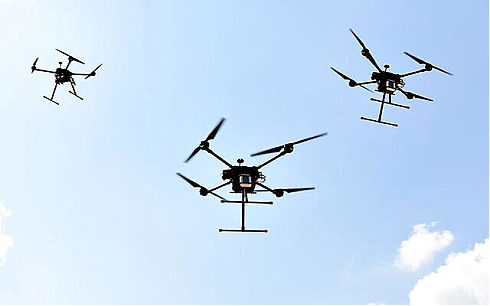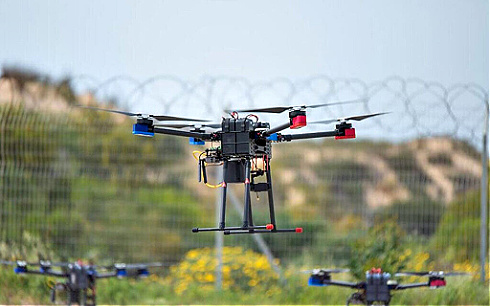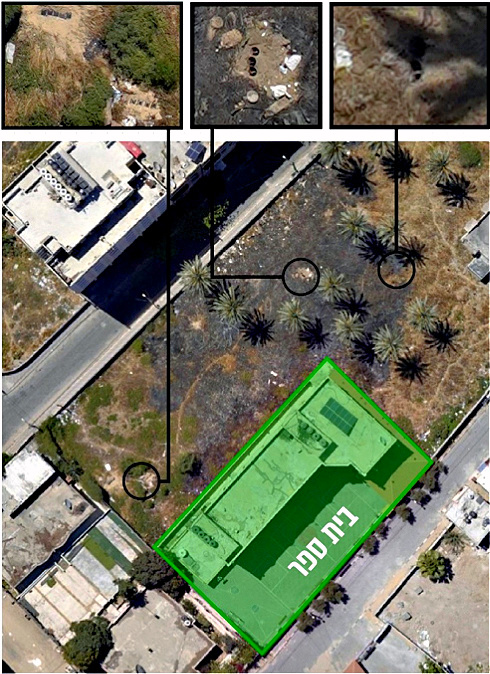Archives
AND MORE...

LIARS Inc.
_____________________

US To Buy Israel's Iron Dome
_____________________

Operation Not-Taking-It-Anymore
_____________________

State of Our Missile-Defense
_____________________
July 10, 2021
Drone Swarms
Mass swarms of dozens or hundreds of drones guided by artificial intelligence are widely considering to be one of the more worrying weapons making their way into the modern battlefield, one with the potential to be far cheaper and thus more available to non-state actors than other advanced munitions.
The world saw a taste of that emerging military technology, albeit a limited one, in May during the 11-day conflict between Israel and terror groups in Gaza, when the Israel Defense Forces used flocks of drones over the Strip to spot rocket launches by Hamas and attack those sites in what appears to be one of the first significant, publicly acknowledged real-world use of the concept.
The military’s use of drones in this way was initially kept classified during the fighting, but has since been permitted to be published in part.
So what the IDF doing with these drones? Read in the detailed piece below.
The Times of Israel | July 10, 2021
In Apparent World FIrst, IDF Deployed Drone Swarms In Gaza FIghting
Military used 'flocks' of small aircraft, all communicating with each other, to locate targets, direct airstrikes, highlighting advances in artificial intelligence-driven combat
By Judah Ari Gross

Israeli military drones fly in formation in an undated photograph. (Israel Defense Forces)
Mass swarms of dozens or hundreds of drones guided by artificial intelligence are widely considering to be one of the more worrying weapons making their way into the modern battlefield, one with the potential to be far cheaper and thus more available to non-state actors than other advanced munitions.
The world saw a taste of that emerging military technology, albeit a limited one, in May during the 11-day conflict between Israel and terror groups in Gaza, when the Israel Defense Forces used flocks of drones over the Strip to spot rocket launches by Hamas and attack those sites in what appears to be one of the first significant, publicly acknowledged real-world use of the concept.
The military’s use of drones in this way was initially kept classified during the fighting, but has since been permitted to be published in part.
During the fighting, the IDF struggled to prevent the Hamas and Palestinian Islamic Jihad terror groups from launching rockets and mortar shells into Israel. By the end of the conflict, over 4,000 projectiles were fired from the Gaza Strip, killing several people in Israel, injuring scores more and regularly sending hundreds of thousands of Israelis to bomb shelters for nearly two weeks.
In a bid to prevent these attacks, the military worked to develop new methods of locating launchpads, which Hamas and Islamic Jihad had buried and hidden throughout the Gaza Strip, in schoolyards, home gardens and otherwise deep within civilian areas. For the first time, the IDF’s artificial intelligence capabilities were brought to bear on the issue, helping human analysts interpret a vast amount of satellite and aerial surveillance imagery to locate the launchpads, some of which were built to be used multiple times. This led Israeli Military Intelligence to declare the Gaza campaign the world’s “first AI war.”
In one use of artificial intelligence, the Israeli military deployed small flocks of quadcopter drones over the southern Gaza Strip with each device monitoring a specific patch of land, The Times of Israel learned at the time. When a rocket or mortar launch was detected, other armed aircraft or ground-based units attacked the source of the fire.
According to the Walla news site, the drone swarms were used dozens of times during the fighting by an until-now classified company of the Paratroopers Brigade, based on concepts developed by the IDF’s experimental Ghost Unit, which is tasked with trying out and creating new tactics and fighting styles for the military.

Israeli military drones fly in formation in an undated photograph. (Israel Defense Forces)
“After a year of preparation and exercises, the situation came and the aerial detection system is able to find the enemy and destroy it and bring the operational achievement we are looking for,” the company commander, who for security reasons can only be identified by his rank and first Hebrew initial, Maj. “Mem,” told the outlet.
“We conducted more than 30 sorties with the drone swarms, which collected precise intelligence and assisted other drones to carry out attacks on the targets,” he said.
During the 11-day campaign, dubbed Operation Guardian of the Walls, Mem’s unit worked with the Elbit defense contractor, which manufactured the drones, and other units within the IDF to refine its capabilities in real time.
According to Mem, while the first use of his unit was in Gaza, that was more of a trial run for the real threat they are preparing for: Hezbollah in Lebanon, which is considered a far more powerful foe than Hamas.
“We’re not resting on our laurels. We are already looking northward and preparing for operations in the next war,” he said.
The military also reportedly plans to expand the use of this technology to other ground units in the future.
However, Israeli drone expert Tal Inbar said it was not clear if these were truly the first attacks by a drone swarm in the world, as has been claimed in media reports in recent days, but this was nevertheless a significant milestone in the use of the technology.

A photograph by an Israeli drone showing 14 underground rocket launchpads in the yard of a school in the Gaza Strip that were used by Palestinian terror groups during May's conflict between the Israel Defense Forces and Hamas. (Israel Defense Forces)
“You can say that this is one of the first times that Israel, officially, is acknowledging it,” he said.
Drone swarms are not particularly new technologies nor do they only exist in the military domain. Indeed, most people have encountered the technology in the form of high-tech light shows, as Israelis did in 2018, when hundreds of drones were flown in formation over the annual Independence Day event on Mount Herzl in Jerusalem.
According to Inbar, the technical definition of a drone swarm is “a number of aircraft flying together for a specific mission. That can be something military or it can be making a bunch of pretty lights in the sky.”
Though the latter seems trivial, Inbar maintained that operating hundreds or thousands of drones at once — with wind and other atmospheric changes — is no small feat, which is why it’s only done by large companies, like Intel in the case of Independence Day, that have the necessary technical abilities.
At the same time, a drone swarm is not just a large number of drones all flying together. In order to qualify, the aircraft must also communicate and coordinate their actions — to at least some extent — requiring some degree of artificial intelligence.
So while Israel’s Independence Day light show would be considered a proper drone swarm, the attack on Saudi Arabia’s Aramco oil facility by multiple drones and cruise missiles allegedly by Iran, would not. (Though Inbar notes that attack revealed sophisticated capabilities in its own right.)
“That wouldn’t be a swarm. I would call that a coordinated attack by several drones,” Inbar said.
What sets drone swarms apart is the autonomy of the swarm, the degree to which they are flying together — like a school of fish or flock of birds — and not just all being flown in formation by separate human operators.

A flock of starlings near the southern Arab Israeli city of Rahat, in the northern Israeli Negev desert, on February 2, 2015. (AFP PHOTO / MENAHEM KAHANA)
According to Inbar, there are a number of different methods for deploying drone swarms, which can range in size from just a handful of vessels to several thousand. In some cases, all of the aircraft work as equals, while in others certain drones have greater computer processing capabilities and act as commanders for the rest.
While humans still give the aircraft their mission — currently, anyway — as swarms get larger, more decision-making is left up to the drones themselves.
“If you have five drones, you can control one, and the others just copy what it’s doing. That’s one level, a lower level of capabilities,” Inbar said.
“But when you have a bigger swarm, how they carry out their mission, you or I as operators don’t necessarily know or control in real time. Say you have 50 aircraft in the air, one of the smarter ones can decide to send five of them to a certain street and another five to another place or to fly in a certain formation,” he said.
The concern
A 2018 United States military study found that this AI-enabled swarming capability made weapons significantly more powerful. In that simulation, 800 drones in a swarm were able to destroy more targets in two hours than 1,000 drones acting independently.
“With all other capabilities being identical, the introduction of a swarm intelligent algorithm significantly increased the swarm’s efficiency, lethality, and capability,” the study’s author, Maj. Sean Williams, wrote.
Drones too were once solely operated by developed countries, but over time the technology became cheaper and more available, and today, they are widely available to the masses, including terror groups, who have used them to deadly effect in conflicts around the world.
Countries have in turn developed methods of downing these individual drones, from nets shot out of guns to advanced spectrum warfare technologies. And indeed the IDF prevented multiple drone attacks by Hamas during the fighting in May, including shooting down one unmanned aerial vehicle with the Iron Dome missile defense system in the first such use of that system.
But many of these tools and tactics would quickly be overwhelmed if mass swarms of dozens or hundreds of autonomous aircraft were used.
Israel’s use of drone swarms during May’s conflict garnered international coverage in large part because it indicates the speed at which this technology is developing and being deployed in the real world.
For now, the use of large swarms requires a high level of artificial intelligence and machine learning technology, meaning it is mostly in the domain of larger nation-states that have the necessary technical capabilities. But that is starting to change.
“Artificial intelligence is not something that’s just for superpowers anymore,” Inbar said.
Original article here.
Log In »
Notable Quotables
"Mr. Netanyahu is one of the most media-savvy politicians on the planet. On Friday he appeared live via video link on 'Real Time with Bill Maher,' taking the host’s alternately sardonic and serious line of questioning with gazelle-like alacrity."
~ Anthony Grant, jourrnalist who has written for many major newspapers and worked in television at Paris and Tel Aviv, interviewing former PM Benjamin Netanyahu on Monday, at the outset of Mr. Netanyahu's new book (more here).


